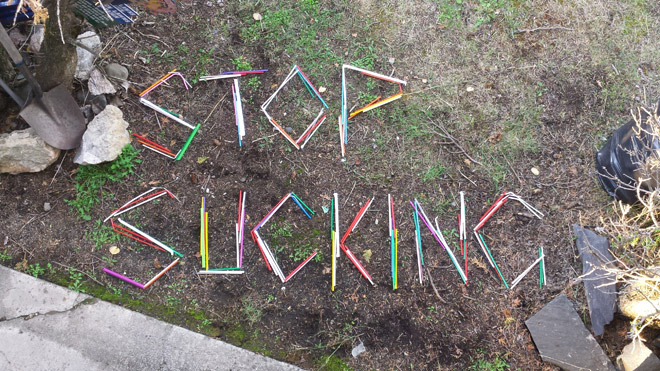By Oliver Berger –
Well, it is confession time again.

I sucked. I sucked for many years of my life. I would go out for meals, start drinking and could suck late, late into the night. I mean, we all did it, my friends, my family, work colleagues, my boss—they all sucked, too. It wasn’t until a few years ago when I learned a few things about sucking, I reconsidered.
I hope you realize by now that I am talking about using straws.
In the US alone, 500 million straws are used every single day. They say in Canada we use 57 million straws per day. That is a lot of people sucking. Because of the popularity of straws, they are also one of the top 10 items gathered during litter pick-ups and ocean clean-ups all over the world. Straws are wreaking havoc on our oceans and wildlife.
Straws are not recyclable items. They are made from a mix of unknown plastics and therefore are an unworthy feedstock for most recycling programs. Really, your next cocktail drink is served to you with a piece of garbage in it. Gross!
Not only that. Using a straw has also been known to create wrinkles around your lips, kind of like smoking a cigarette does. With every sip you take, you are also inhaling extra air which in turn can make you gassier. That is no bonus for anyone.
I understand there might be reasons where straws are necessary, for example patients or elderly who cannot physically drink from a cup. Fortunately, substitutes are available.
Previous to the plastics revolution, natural drinking straws were used for thousands of years, and were made from rye. In 1888 a man named Martin Stone patented the spiral winding system for producing paper straws. The straws were coated with a layer of paraffin to prevent sogginess. These paper straws caught on in popularity, and were the forerunner of today’s single-use plastic drinking straws.
Paper straws are returning. Greenmunch© and Aardvark® are two of a few companies that have come up with many variations of biodegradable straws: cocktail sizes, bendy and spiral types, and even jumbo ones for smoothies. They use starch based resins, corn, or bamboo to help with the waterproofing. After the straw is used, it can be thrown into your compost bucket with no quarrels.
Stainless steel and glass straws have also become a more sustainable option. The bonus here is they can be reused over and over again after a simple wash.
These are all great alternatives for those people who are determined to continue sucking.
Refuse
Tofino went strawless for Earth Day in 2016; 41 businesses jumped on board and continue to do so now. Ucluelet is waving in and launched its Straws SUCK campaign October 18 of this year. Sea-Tac airport landed in and was strawless for the entire month of September. London’s Soho neighbourhood created Straw Wars, which has an interactive map online showing any business in the world committed to going strawless. Sign your business up today at www.strawwars.org.
Adrian Grenier with Lonely Whale Foundation has created a Strawless Ocean campaign and it is creating some ripples with its clever videos. Check this one out: https://www.youtube.com/watch?v=Q91-23B8yCg.
You can join that campaign by creating a challenge URL. I did and here is my challenge to you:
Hey @williamslake, @100milehouse, @quesnel, @caribooregionaldistrict, I did #stopsucking now it’s your turn! Click here to join: https://stopsucking.strawlessocean.org/i/9lvge2y.
I am happy to say that now, I no longer suck!
When are you going to have the last straw?
Oliver has a 36-year degree in life, starting out in the Spokin Lake area, spending adolescence in Williams Lake, and then venturing throughout the world on a quest of always learning new things. His priorities include dedication to and education about waste management.
